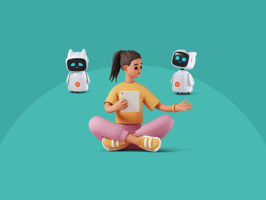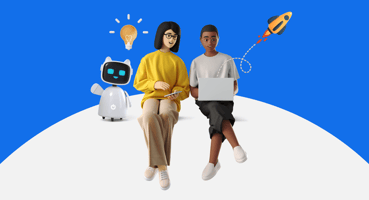The use of artificial intelligence (AI) in education has the potential to revolutionize education...
AI in Education Pt. 2: Teaching AI Ethics and Awareness in the Classroom
In the first part of this series, we explored how to introduce AI literacy to students and teach them to use AI tools responsibly. Now, it’s time to focus on an equally important aspect: the ethical implications of AI.
AI’s presence in education raises pressing questions about privacy, bias, and accountability. As educators, we have a unique opportunity to guide students in understanding these challenges while equipping them to think critically about the role of AI in their lives. This blog post will dive into the key ethical issues AI presents and share practical ways to integrate these discussions into your classroom.
Why Ethics Matters in AI Awareness
AI isn’t just a technology: it’s a tool that shapes decisions, influences behavior, and impacts society on multiple levels. To navigate this landscape responsibly, students need to understand the ethical dimensions of AI. Here are three critical areas to explore:
1. Privacy and Data Security
AI tools often collect data to function effectively, whether it’s tracking student progress in learning apps or analysing online behavior to personalize recommendations. While this can enhance learning experiences, it also raises serious questions:
- How is student data stored and used?
- Who has access to this information, and how secure is it?
- What are the risks of sharing personal information with AI-powered tools?
Without an understanding of these issues, students may unknowingly compromise their privacy.
Example for Discussion: Ask your students: “If an app collects data about your study habits to help you improve, would you use it? What if the app also sells this data to advertisers? Does that change your opinion?”
2. Bias in AI
AI systems learn from data, and if that data reflects societal biases, the system will too. For instance:
- A facial recognition tool might perform better for lighter-skinned individuals if it was trained primarily on lighter-skinned faces.
- An AI essay-grading tool might favor certain writing styles over others, potentially disadvantageous to students from different linguistic or cultural backgrounds.
Bias in AI is a subtle but significant issue, and it’s crucial for students to recognise it and question AI outputs critically.
Example for Discussion: Provide students with two AI-generated summaries of a controversial topic. Ask them to identify any biases in the summaries and discuss how those biases might have occurred.
3. Responsibility and Accountability
Who’s to blame when AI makes a mistake? Is it the developer, the user, or the system itself? This question becomes especially important as AI increasingly influences decisions in areas like healthcare, law, and education.
Example for Discussion: Pose a scenario: A self-driving car, controlled by an AI system, makes an error and causes an accident. The car's owner was in the vehicle but not actively controlling it. Who should be held accountable: the car's owner, the manufacturer, or the developers of the AI system? Why?
How to Bring AI Awareness and Ethics into the Classroom
Teaching AI ethics doesn’t mean overhauling your curriculum. Small, intentional steps can make a big difference. Here are some practical ways to bring these discussions to life:
1. Use Scenarios to Explore Ethical Dilemmas
Presenting hypothetical situations helps students grapple with complex ethical questions in a safe and structured way. These scenarios can be tailored to your subject area or classroom context.
Scenario Ideas:
- AI in Grading: An AI tool grades essays but doesn’t explain its reasoning. Should teachers rely on it?
- AI in Hiring: A company uses AI to screen job applicants, but the tool seems to favor certain demographics. Is this ethical?
Classroom Activity: Divide students into small groups and assign each group a scenario. Have them discuss:
- What the ethical issue is.
- Who might be affected and how.
- Possible solutions to address the issue.
Each group can present their findings to the class, encouraging a broader discussion.
2. Teach Students to Evaluate AI Tools
Students use AI tools every day, often without questioning their accuracy or limitations. Teaching them to critically evaluate these tools is an essential skill.
Steps to Evaluate an AI Tool:
- Understand the Purpose: What is the tool designed to do?
- Examine the Data: What kind of data does it collect, and how is it used?
- Identify Biases: Are there patterns in the tool’s outputs that suggest bias?
- Test Its Limits: What does the tool struggle with, and why?
Classroom Activity: Choose an AI tool your students are familiar with (e.g., a grammar checker or a photo editing app). Have them test the tool with various inputs and record:
- What the tool does well.
- Where it falls short.
- Any patterns or biases they notice.
Encourage students to share their findings and discuss how they might use the tool responsibly.
3. Highlight AI’s Real-World Impact
Connecting AI ethics to real-world examples makes the topic more engaging and relevant. Show how AI is transforming industries, from healthcare to art, and explore the ethical questions these changes raise.
Examples to Share:
- Healthcare: AI diagnosing diseases faster than doctors, but only for certain demographics.
- Art and Design: AI creating digital art that challenges ideas of originality and authorship.
- Business: AI analysing customer data but potentially invading privacy.
Classroom Activity: Assign students to research how AI is used in a specific industry. Have them present:
- The benefits of AI in that field.
- The ethical challenges it raises.
- Possible solutions to those challenges.
4. Promote Transparency in AI Use
Encourage students to reflect on their own use of AI tools and be transparent about how they use them. This fosters accountability and ethical behavior.
Classroom Policy Idea: If students use AI for assignments, require them to:
- Describe how they used the tool.
- Reflect on what the tool did well and where they had to step in.
- Discuss whether they would use the tool again and why.
This approach not only demystifies AI but also helps students see it as a tool, not a crutch.
Empowering the Next Generation of Responsible AI Users
AI is transforming the way we live, work, and learn. By teaching students to think critically about its ethical implications, you’re preparing them to use this technology thoughtfully and responsibly.
This is just the beginning. Stay tuned for the next part of this series, where we’ll dive into hands-on lesson ideas for implementing AI-tools in the classroom.
What are your thoughts on teaching AI ethics? Have you tried incorporating these discussions into your teaching? Share your experiences in our FB group, we’d love to hear from you!



